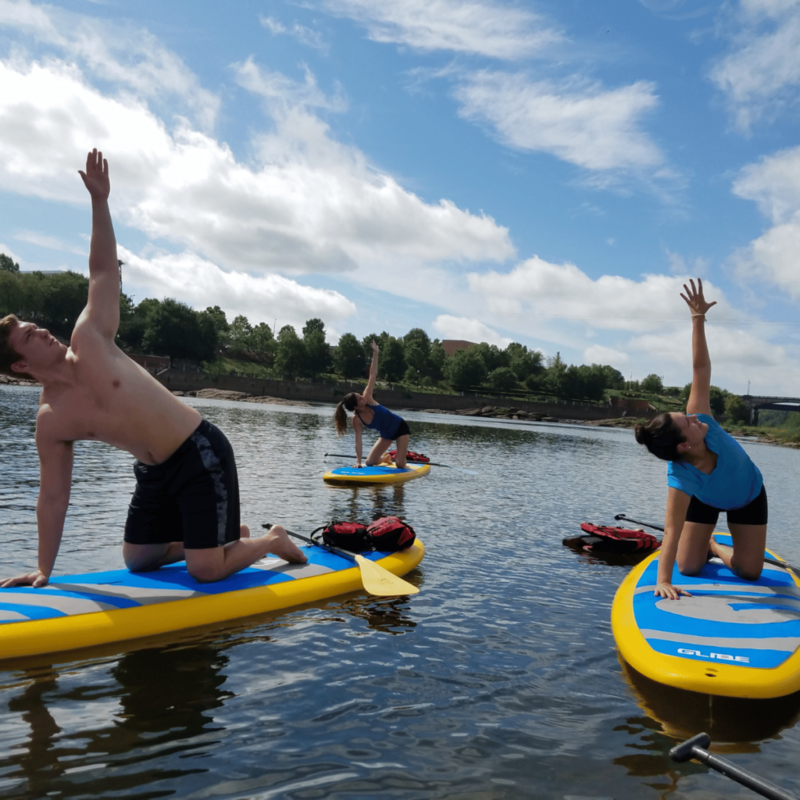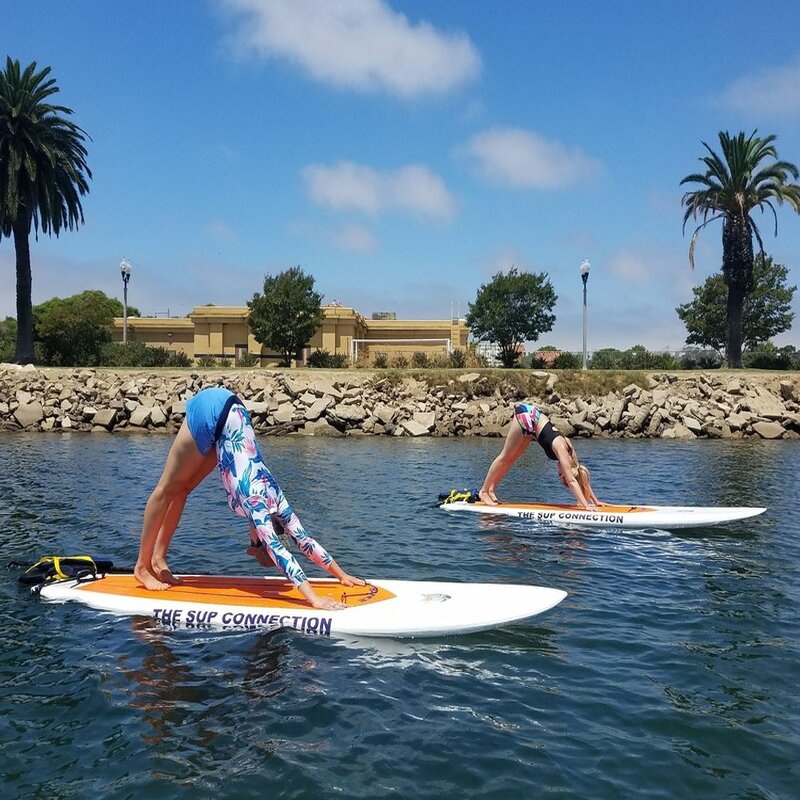Stand-Up Paddleboard (SUP) Yoga is a blend of traditional yoga and paddleboarding. It synergizes the ancient practice of yoga with the modern sport of paddleboarding. SUP Yoga takes yoga off the mat and onto the water. It offers a refreshing twist to traditional yoga routines. Whether on a serene lake, flowing river, or even ocean waves, SUP Yoga brings practitioners closer to nature. It enhances their connection with the natural elements.
The Evolution of SUP Yoga
SUP Yoga has seen substantial growth in recent years. This hybrid exercise combines the mindfulness of yoga with the balance challenges of paddleboarding. The trend originated from the surf-centric communities of Hawaii and California. Paddleboarders began incorporating yoga poses into their routines. As a result, fitness enthusiasts worldwide quickly embraced it.
Historical Background of Paddleboarding
Paddleboarding is not a new phenomenon. Its history traces back thousands of years to African and South American fishermen. They used boards and paddles to navigate through water. Modern paddleboarding evolved in Hawaii. It gained popularity in the 1940s among surf instructors. They used paddles while standing on their boards to have better visibility of incoming swells. It introduced paddleboarding to recreational surfers.
Yoga’s Journey to the Water
Yoga’s roots are ancient, deeply embedded in Indian culture. The union of yoga and water adds a dynamic element to the traditional practice. SUP Yoga demands a higher level of concentration and core strength. This takes the practitioner’s focus and stability to new heights. As both activities share an ethos of mindfulness and balance, the merger feels natural and enriching.

The Health Benefits of SUP Yoga
Engaging in SUP Yoga offers a multitude of health benefits. It combines cardiovascular exercise, strength training, and relaxation techniques. It promotes physical, mental, and emotional well-being. Practitioners find themselves in a harmonious state of mind. They experience less stress and a rejuvenated spirit.
Physical Benefits
SUP Yoga is a full-body workout. It engages muscles that are often neglected during traditional yoga on solid ground. The instability of the paddleboard requires constant core engagement. It enhances core strength and balance. Additionally, it tones the legs, arms, and back. The constant balancing act sharpens proprioception, our sense of body position. It also improves overall stability and coordination. The combination of yoga poses and paddling increases cardiovascular endurance. It results in better heart health and lung capacity.
Mental Benefits
Immersing oneself in nature while practicing yoga brings immense mental clarity. The water’s gentle rocking soothes the mind. It is conducive to calming both the nervous system and reducing anxiety levels. The natural environment, coupled with the meditative aspect of yoga, helps practitioners achieve a state of mindfulness. This heightened awareness improves focus and concentration. Practitioners report feeling more connected to their surroundings. They gain a deeper sense of emotional balance and inner peace.
Preparing for SUP Yoga
Getting started with SUP Yoga requires some preparation. Proper equipment, attire, and basic skills are essential. Beginners may also find guided classes beneficial. Instructors can tailor sessions to individual skill levels.
Essential Equipment
The primary piece of equipment is, of course, the paddleboard. Inflatable paddleboards are often preferred for their portability and stability. They are more forgiving when practicing yoga poses. A quality paddle with an adjustable handle is crucial. It ensures ease of use regardless of water conditions. Additionally, an anchor can keep the board stationary, preventing it from drifting during the practice. Proper attire is also vital. Wear moisture-wicking, quick-drying clothing for comfort and practicality.
Basic Skills and Techniques
Before attempting SUP Yoga, gaining some basic stand-up paddleboarding skills is advisable. Familiarize yourself with paddling techniques. Practice balancing on the board. Learning how to fall safely can also be beneficial. Once comfortable with the SUP, start incorporating beginner yoga poses. Begin with poses that focus on balance and stability. Poses like Mountain Pose (Tadasana) and Downward-Facing Dog (Adho Mukha Svanasana) are excellent starting points.

Taking Your Practice to the Next Level
As you become more comfortable with SUP Yoga, advancing your practice adds a new layer of excitement. Exploring new poses and techniques keeps the practice dynamic. It continuously challenges both body and mind.
Advanced Yoga Poses
Once you’ve mastered the basics, incorporating advanced poses can amplify the benefits. These poses challenge balance and flexibility. For example, Full Wheel Pose (Urdhva Dhanurasana) and Crow Pose (Bakasana) are excellent for advanced practitioners. These poses require substantial strength, stability, and concentration. Transitioning between poses also adds complexity to the workout. Moving from Warrior II (Virabhadrasana II) to Half-Moon Pose (Ardha Chandrasana) tests your balance and coordination.
Exploring Different Water Bodies
Experimenting with various water settings can also elevate your experience. Each body of water offers unique challenges and opportunities. Lakes and calm rivers provide ideal conditions for honing skills. Practicing on the ocean introduces an additional element of unpredictability. It forces the practitioner to remain highly attuned to their environment. This variability can make the practice more exhilarating and rewarding.
Community and Social Aspects of SUP Yoga
SUP Yoga isn’t just a solitary pursuit. It fosters a sense of community among practitioners. Sharing experiences and learning from each other enriches the practice.
Group Classes
Participating in group classes offers numerous benefits. It provides a structured environment where seasoned instructors can provide guidance. Beginners often find these sessions less intimidating. They offer the camaraderie of sharing the practice with peers. Many group classes incorporate warm-ups, skill-building segments, and relaxation periods. This ensures a well-rounded SUP Yoga experience. Group sessions can also be a fun way to meet like-minded individuals and build new friendships.
SUP Yoga Retreats
For a more immersive experience, SUP Yoga retreats are a fantastic option. These retreats offer intensive practice sessions in picturesque settings. They include workshops, guided meditations, and other wellness activities. Retreats allow practitioners to deepen their practice. They also help explore new destinations and connect with a global community of SUP Yoga enthusiasts.
Tips for a Successful SUP Yoga Practice
To ensure a fulfilling and enjoyable SUP Yoga experience, some tips can be very useful. These can help make your practice safer and more effective.
Safety Precautions
Safety should always be a top priority. Always let someone know your practice location and expected return time. Use a life vest if needed, especially if you’re not a strong swimmer. Check weather conditions before heading out. Avoid practicing in harsh weather or choppy waters. Practicing near the shore and in designated areas can minimize risks.
Progressing Gradually
Patience is key in mastering SUP Yoga. Progress gradually, starting with basic poses and moving to advanced ones as your skills improve. Don’t be discouraged by initial difficulties. The learning curve can be steep, but persistence pays off. Celebrate small milestones. Each successful pose or improved balance is a step forward in your journey.

The Future of SUP Yoga
The popularity of SUP Yoga shows no signs of slowing down. As more people discover its benefits, innovations and trends evolve.
Technological Advancements
Technology is playing a role in the growth of SUP Yoga. From inflatable boards to waterproof electronics, the gear is continually improving. Advances in paddleboard design make them more stable and versatile. Future trends may include smart boards with built-in metrics to track performance. Virtual reality may also provide interactive training sessions for enthusiasts worldwide.
Global Expansion
SUP Yoga is growing beyond its coastal origins. Urban areas with rivers and lakes are adopting the trend. As more people seek holistic wellness activities, SUP Yoga’s appeal widens. It is becoming a staple in fitness and wellness programs across diverse geographies.
Conclusion
SUP Yoga is more than just a fitness trend. It’s a holistic practice that merges physical, mental, and spiritual well-being. From the tranquil settings to the physical challenges, every aspect contributes to a unique experience. Whether you’re a seasoned yogi or a beginner, it offers something enriching. It’s an opportunity to deepen your connection with nature, enhance your yoga practice, and achieve a balanced state of mind and body. Embrace the wave of wellness that is SUP Yoga. Dive into its myriad benefits and enjoy the peaceful waters and endless horizons.
By incorporating these tips and insights into your routine, you can maximize the benefits of SUP Yoga. So grab your paddleboard, head to the nearest water body, and embark on this transformative journey.
